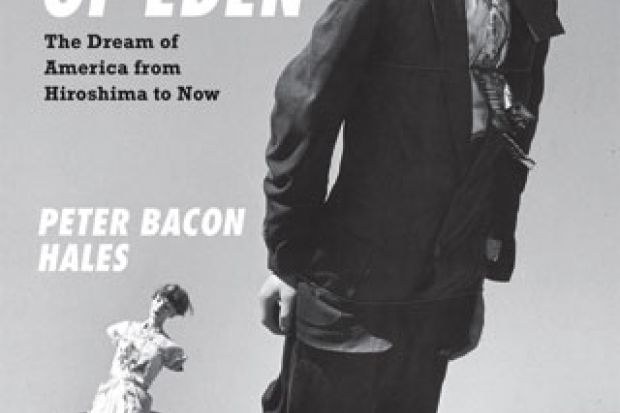This is an emphatically cultural history of the US from 1945 to the present – and beyond, should readers wish to access the blog on which Peter Bacon Hales promises to pursue the themes laid out here. The book’s approach to culture is expansive, taking in the scripts of television programmes and one iconic movie (Miracle on 34th Street), the various models of housing in the planned community of Levittown, New York, images of nuclear holocaust, the changing scope and design of video games, and the lyrics of popular songs. Hales’ goal is to examine “how the most influential forms of media and cultural representations chose to frame the national struggle for identity and meaning”. He sees American identity as fragile, in constant need of reinvention and, since the first hovering mushroom cloud came to define a world always on the brink of annihilation, veering between fear and optimism. The early chapters of the book limn these opposing states.
The opening chapters on US nuclear testing are powerful and revelatory. Hales writes about William Laurence, science writer for The New York Times and propagandist for the Bomb. “Laurence originated what would rapidly become the standard description of nuclear detonation: he split the occurrence in two with infinite power, sublimity and triumph above, high in the skies, and horror, death and destruction below.” Hales goes on to discuss how Life magazine portrayed the destruction of Bikini Atoll and the evacuation of its population: “Under Bikini’s palm and pandanus trees, bright in the South Sea sun and dark in the shadow of the Bomb, primitive man and progressive man held palaver.” The newsreels of the event were equally lyrical, but Hales goes behind the scenes to the out-takes and discovers “how fully the rough splintered edges of historical fact put the lie to every part of the composite script of American Cold War exceptionalism that found its way into common knowledge”.
The other side of “The atomic sublime” (as Hales titles one of his two chapters on testing) is life as it was lived in Levittown and similar communities in the 1950s. As is the case throughout the book, the chapter is richly illustrated, including snapshots taken by some of Levittown’s original inhabitants. Hales describes how the model homes changed over time from “tightly enclosing, womblike miniature spaces, pushing the family into close proximity when inside” to larger structures, with picture windows and built-in television sets, from which children and adults “exploded from the houses into the fluid space of community”. Levittown was a “paradigmatic Cold War cultural landscape, simultaneously huddling place and open community, with neither extreme particularly far from the other”.
In succeeding chapters, Hales discusses the shifting role of women (through the scripts of I Love Lucy), the civil rights movement (Martin Luther King’s speech at the march on Washington), the anti-war movement (the 1968 Chicago Democratic Convention and the violence at Kent State University), the counterculture (multiple groups) and the rise of our digital present (the face-off between Grand Theft Auto and The Sims). At times, his conclusions seem to move well beyond the evidence he presents, as in the contrast he draws between Americans on holiday taking pictures of designated beauty spots to “counterculturists [who] were waking to the sun”. Even when they had abandoned their communes, Hales suggests, “they carried with them that awakened sense of having lived in the midst of sacrality. Long after the communes had been abandoned or turned into tourist traps, the reinvigoration of America’s sense of miraculous occupation of a divinely granted place of beauty and promise remained.” Remained for whom?
Hales’ focus on the counterculture and its echt American effort at reinvention and redemption leads him to count among its legacies a “culture hypersensitized to global climate and ecological frailties”, as well as debates about “the rights of the old and the infants and even the unborn, sensitized to issues of life, of humanity, of dignity and rights”. These claims seem overblown and contradictory; they omit the social and political movements that marked the period and perhaps most problematically they are innocent – as is the book as a whole – of any serious consideration of class. In this respect, Outside the Gates of Eden reflects too faithfully the country it intends to analyse.
Outside the Gates of Eden: The Dream of America from Hiroshima to Now
By Peter Bacon Hales
University of Chicago Press, 496pp, £28.00
ISBN 9780226313153 and 6128610
Published 23 April 2014
Register to continue
Why register?
- Registration is free and only takes a moment
- Once registered, you can read 3 articles a month
- Sign up for our newsletter
Subscribe
Or subscribe for unlimited access to:
- Unlimited access to news, views, insights & reviews
- Digital editions
- Digital access to THE’s university and college rankings analysis
Already registered or a current subscriber?





